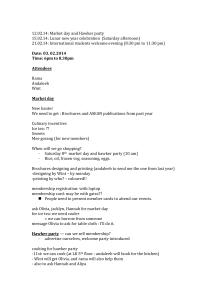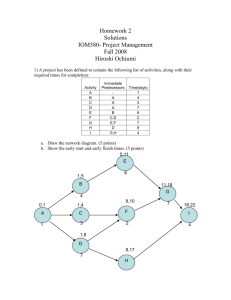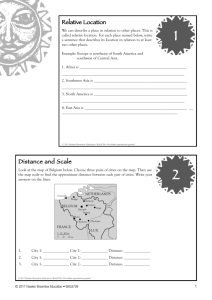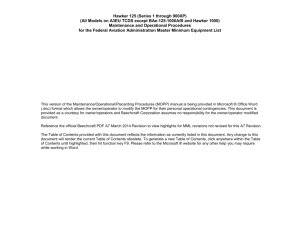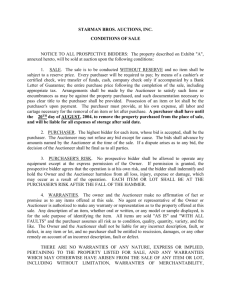Hawker Scholarship Presentations
advertisement
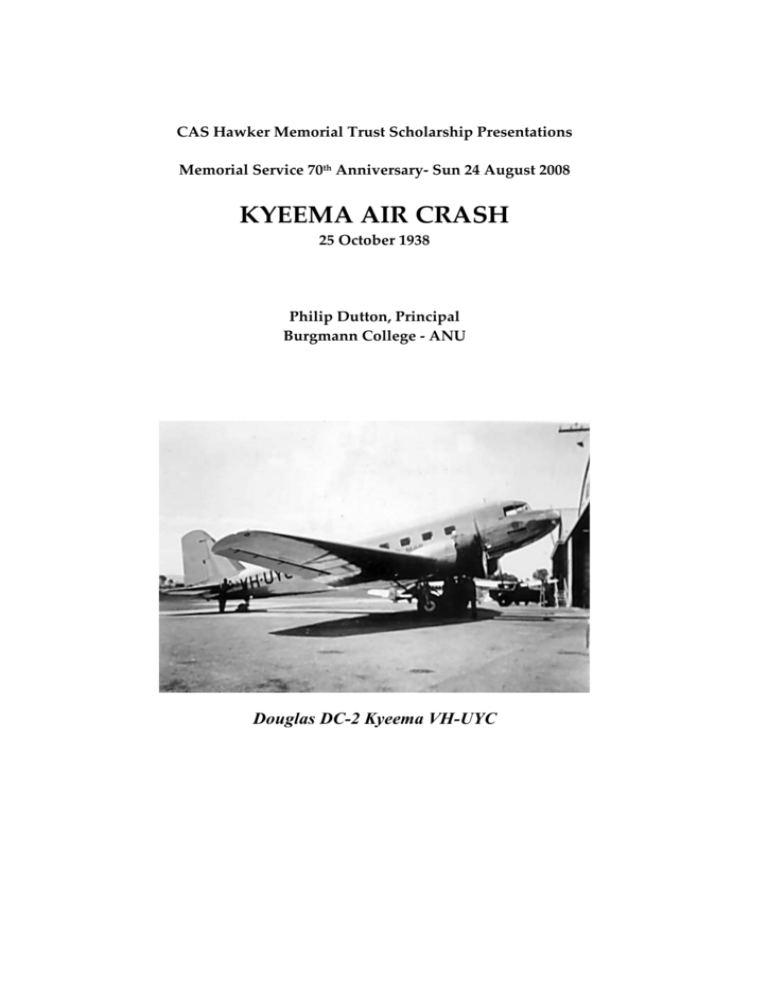
CAS Hawker Memorial Trust Scholarship Presentations Memorial Service 70th Anniversary- Sun 24 August 2008 KYEEMA AIR CRASH 25 October 1938 Philip Dutton, Principal Burgmann College - ANU Douglas DC-2 Kyeema VH-UYC 2 It is 11.15am on October 25, 1938. The weather is clear as the ANA Douglas DC-2 Kyeema, radio call sign VH-UYC is preparing to fly out of Adelaide and head to Melbourne’s Essendon Airport. The DC-2 is fully booked with 14 passengers and the pilot, co-pilot, cadet pilot and air hostess – a company of 18. Among the passengers are three South Australian vignerons on their way to Canberra for a wine industry conference. They are Hugo Gramp, Tom Hardy and Sidney Hill Smith – all represented here today by their respective son and grandsons and partners and other family members. In their company is a most respected Member of Parliament both locally and nationally Charles Hawker – represented here by so many members of the Hawker family as well as a strong contingent of current and most recently awarded Hawker Scholars and members of the Hawker Trust – the trustees themselves. The busy DC-2 cockpit is high off the ground at the front with unusual light fittings like two nostrils under the nose cone. Passengers enter through a door much lower to the ground near the rear with seven seats and windows either side in a relatively narrow and squared off cabin. The passengers are on board a new generation aeroplane of high speed about to fly at nearly 200mph. As it rumbles along to the end of the runway it looks a little similar to the British aircraft that just three weeks before had brought British Prime Minister Neville Chamberlain back to London from talks with Hitler in Munich. He confidently hailed the press with the seemingly reassuring message on 30 September of Peace in Our Time. Did this news from the mother country enter the conversation between Minister Hawker, those leading winemakers and other senior legal identities taking their seats? The spluttering and coughing of the engines then charge up Kyeema as she accelerates along the runway and is reassuring to the regulars, and most exciting for the novices including a honeymoon couple beginning the adventure of their lifetime. At 11.22am Kyeema takes off. Airborne technology is improving rapidly and is way ahead of ground safety technology and systems. Air navigation was based on visual sightings and ground speed checks. Radio navigation as such is years away from being introduced. After crossing the Great Dividing Range in the early afternoon, Kyeema hits heavy cloud in the Melbourne basin. Although the pilots are confident in their visual identification of Daylesford, they are mistaken. What they see, in fact, is Sunbury. They do not do their cross-checks against the ground speed, and they are nearly 30km ahead of where they thought they were. As a result, at 1.45pm Kyeema crashes suddenly with little or no warning into the western slopes at the top of Mt Dandenong. 3 Herald Weekly Times depiction following the crash There is a Federal Minister, three wine industry leaders, a couple on their honeymoon and prominent members of the legal fraternity including a King’s Council and the crew of four. All eighteen aboard die instantly upon impact. We remember: Captain Alfred Webb, Junior Captain Allan Steen, Air Hostess Elva Jones, Cadet Pilot Philip Pring. And the passengers: Leonard Abrahams KC, Alfred Gain, Hans and Stella Gloe, Gordon Goddard, Hugo Gramp, Thomas Hardy, The Hon Charles Hawker MHR, George Ling, James Massie, Vaughan Pate, Elizabeth Schrader, Lancelot Shirley and Sidney Hill Smith. The plaques above the Kyeema crash site It is speculated that the highly experienced pilots, Captain Alfred Webb and Co-pilot, Allan Steen tried to radio for bearings as they approached Melbourne, but the inadequacy of the radio system failed them. The system was jammed. It was suggested afterwards that a Lockheed 10 coming in to Essendon from Hamilton had used radio with such a strong signal that blocked out other signals like that 4 from Kyeema. At 11.59am an incoming DC-3 from Sydney not far from the Dandenongs was heard to ask over the radio the ominous question to a confused and cloudy Essendon Airport: Where’s Kyeema? She had gone down 14 minutes earlier. Aviation in Australia was in its infancy, but the accident could have been avoided. The aviation industry had been imploring the Federal Government for many years to establish a safer system of air control that could have prevented or at least corrected the Kyeema's navigational error. An accident was sure to happen. The government procrastinated as the kinds of changes deemed necessary were considered costly. The story of Kyeema starts in 1938, but it was in 1964, when Macarthur Rob was appointed to the DCA in air safety investigation that Mac, in this role, gained access to records of all the aircraft accidents in Australia and took a special interest in Kyeema. According to him: "A profound shock swept through the government. One of their own, a Government Minister, had been killed in the Kyeema air crash. Was it this that was the catalyst for air control change? Yes! Both the crash and the subsequent enquiry showed the government in a poor light. The publicity was extremely negative, was coming from prominent people and was unrelenting. There were a lot of red faces in government. As with many issues of change, a tragedy and public pressure had to happen before change was implemented." The enquiry would see the establishment of the Department of Civil Aviation (DCA) and its system of air traffic control. Air flight was an elitist method of travel in the early days, something for the wealthy and influential. Perhaps it is in some way a tribute to the tragedy of Kyeema and other early air disasters like it, that Australia has such a safe record of air travel today and that it is no longer an elitist mode of transport for our wide continent. At around the same time Macarthur Rob became interested in Kyeema, he had been moved by a talk given by Maurie Seymour, a former Shire Councillor, who had been a young man at the time of the accident and had seen the aftermath of the plane crash. My own great friend Fr Graeme Brennan, Senior Chaplain at Brighton Boys Grammar, in fact tells the story of his own father, Bryan Brennan, a boy in his late teens in 1938 (about the same age as our new Hawker scholars) who was in Northcote and upon hearing about it was among the first civilians to arrive on his motor bike with his brother to survey the awful scene. By further coincidence, Fr Brennan, an aviation enthusiast as well as an ordained member of the Anglican community, will fly over Melbourne as a birthday gift in a DC-3 (not a DC-2) in late October and will especially remember Kyeema as they fly over the Dandenongs and offer a prayer for the victims. The 1978 Memorial cairn 5 On October 25, 1978 a memorial cairn was officially unveiled, forty years after the crash and just metres from where the Kyeema finally came to rest in flames and in pieces. The victims are listed alphabetically and the narrative plaque reads this way: FIFTY METRES BELOW THIS POINT ON 25 OCT 1938 AUSTRALIAN NATIONAL AIRWAYS DC-2 ‘KYEEMA’ PLUNGED TO DESTRUCTION WHILE THE MOUNTAIN WAS ENVELOPED IN CLOUD. ALL 18 PERSONS ON BOARD PERISHED. FROM THE RECOMMENDATIONS OF THE SUBSEQUENT ENQUIRY HAVE EVOLVED THE AIR TRAFFIC CONTROL SYSTEMS IN USE THROUGHOUT AUSTRALIA TODAY. THIS PLAQUE, PLACED BY THE MOUNT DANDENONG HISTORICAL SOCIETY WITH ASSISTANCE FROM O. GRAMP & SONS, THOS. HARDY & SONS, S. SMITH & SON, AUSTRALIAN FEDERATION OF AIR PILOTS AND FORESTS COMMISSION OF VICTORIA WAS UNVEILED ON 25 OCT 1978 TO MARK THE 40th ANNIVERSARY OF THE DISASTER. On this occasion, and again on the fiftieth anniversary of the crash, the children and relatives of those who died were in attendance when another DC-3, first flown on the week Kyeema crashed, flew overhead. As we approach the seventieth anniversary of Kyeema on October 25, it may be that we are already heeding Macarthur Rob’s call that: "The seventieth anniversary ought to be commemorated in some way. The Kyeema air disaster was the most influential event in Australian aviation history; it changed forever aviation as we knew it." Just four weeks ago on Sunday 27 July, with the help of a former colleague and friend Sue Nicholson, I found my way to the crash site near the Cnr of Ridge and Observatory Roads, Mt Dandenong, and felt a forensic shiver as I looked beyond the stone cairn out to the West at exactly, by sheer coincidence, 1.45pm and felt the sun pierce a hole in the tree canopy – a canopy that was so much more dense everywhere else. It lit up a section of ground that had been heavily gouged at some time in the past. However, any forensic notions gave way to the cold chill of reality, a deep feeling of sadness, a moment of reflection and a prayer for the lives lost. Sunday July 27, 2008 What makes this air disaster so doubly, deeply sad for us today goes way beyond its implications for aviation. There were 18 lives lost suddenly and horribly on that day nearly 70 years ago and we think of their families and friends in the days and many years of incalculable loss thereafter. 6 But we instinctively look to our leaders around times and moments of disaster and we remember them with the heightened significance of public as well as private loss. Charles Hawker by 1938 had gained a reputation and growing stature in this country as an exceptional war veteran and survivor, pastoralist and Minister of the Commonwealth for his courage and principles and in his approach to the formidable problems of the thirties. He was regarded by the public at large as a great man. At the personal level, he remains deeply embedded in our hearts as an example of hard work, integrity, vision and leadership that typifies the spirit of this wonderful agricultural, wool growing and winemaking region of Australia. He gives us, and especially Hawker Scholars, something to aim for and to be guided by and his work, as well as ours, goes on.



